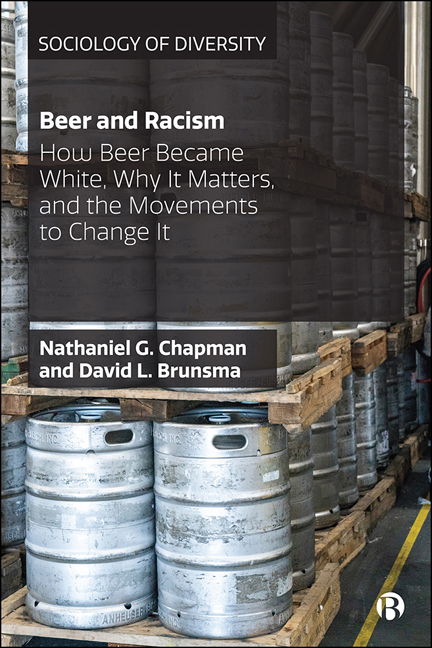Book contents
- Frontmatter
- Dedication
- Contents
- About the Authors
- Acknowledgments
- Foreword
- Series Editor Preface
- 1 Brewing Up Race
- 2 Racism, Brewing, and Drinking in US History
- 3 The Making of the (White) Craft Beer Industry
- 4 The Paths to Becoming a Craft Brewer and Craft Beer Consumer
- 5 Exposure, Marketing, and Access: Malt Liquor and the Racialization of Taste
- 6 Gentrification and the Making of Craft Beer White Spaces
- 7 #WeAreCraftBeer: Contemporary Movements to Change the Whiteness of Craft Beer
- Appendix A Respondents to the Semi-Structured Interviews
- Appendix B Interview Protocol
- References
- Index
3 - The Making of the (White) Craft Beer Industry
Published online by Cambridge University Press: 25 February 2021
- Frontmatter
- Dedication
- Contents
- About the Authors
- Acknowledgments
- Foreword
- Series Editor Preface
- 1 Brewing Up Race
- 2 Racism, Brewing, and Drinking in US History
- 3 The Making of the (White) Craft Beer Industry
- 4 The Paths to Becoming a Craft Brewer and Craft Beer Consumer
- 5 Exposure, Marketing, and Access: Malt Liquor and the Racialization of Taste
- 6 Gentrification and the Making of Craft Beer White Spaces
- 7 #WeAreCraftBeer: Contemporary Movements to Change the Whiteness of Craft Beer
- Appendix A Respondents to the Semi-Structured Interviews
- Appendix B Interview Protocol
- References
- Index
Summary
Without a full accounting of history, we are likely to repeat it. Understanding how beer became racialized helps us to grapple with the continuities of its whiteness and the maintenance of racist practices within the beer industry writ large. Prior to Prohibition, the US brewing industry consisted of large regional breweries and small local breweries, and before that, a deeply rooted tavern system and related cultures. At the historical peak of brewing in the US in 1887, there were 2,011 breweries; at the beginning of Prohibition in 1920, the number stood at 1,179 (Brewers Association, 2018a). These breweries largely used recipes and techniques brought over by white European immigrants. Some of the more popular styles were pale German lagers and pilsners. These would come to define what beer was in the US. Upon ratification of the 18th Amendment, the production of alcohol came to a screeching halt. Breweries were forced to close their doors and hope that ‘the great experiment’ would come to a timely end. That day came on December 5, 1933.
After the repeal of Prohibition, many breweries remained closed— for some, the damage done during Prohibition was too great to overcome. Other breweries were able to reopen and continue their operations under a new structure: the three-tier distribution system. Under this system, beer passes through three-tiers— the brewer, a wholesale distributor, and a retailer— before it reaches the consumer. Following the repeal of Prohibition, several firms, including Pabst, Anheuser-Busch, Coors, and a few others, were able to use their considerable wealth to acquire smaller local and regional breweries. The period following the repeal of Prohibition in 1933 and up through the 1970s— a period of acquisition and consolidation, the death of old regional breweries, and the capitalist myopia of the bottom line— had great effects on beer itself but also further solidified the racialized structure of the industry that existed prior to Prohibition.
As it relates to the history of craft beer in the US, the consolidation and acquisition of breweries, which began prior to Prohibition and intensified in the years following its repeal, led to high levels of industry concentration and very little innovation.
- Type
- Chapter
- Information
- Beer and RacismHow Beer Became White, Why It Matters, and the Movements to Change It, pp. 49 - 74Publisher: Bristol University PressPrint publication year: 2020



